





Index style finger release hooked on d-loop.

Buckle system on a wrist strap archery release.
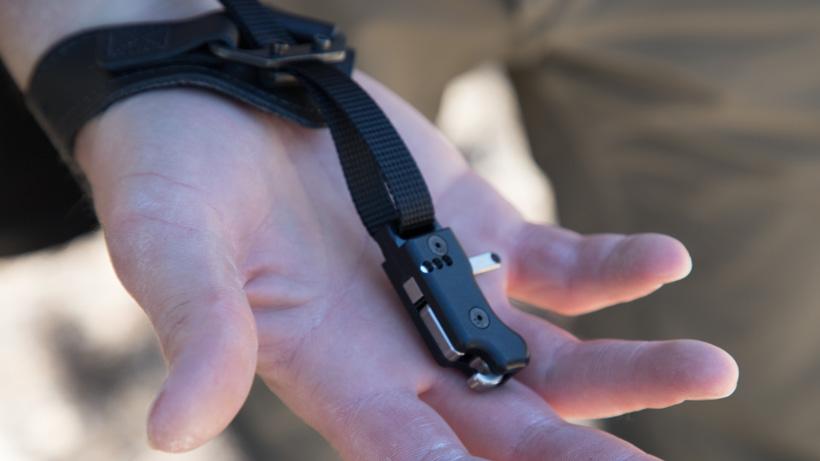
Carter Lucky release showing the adjustable nylon strap.
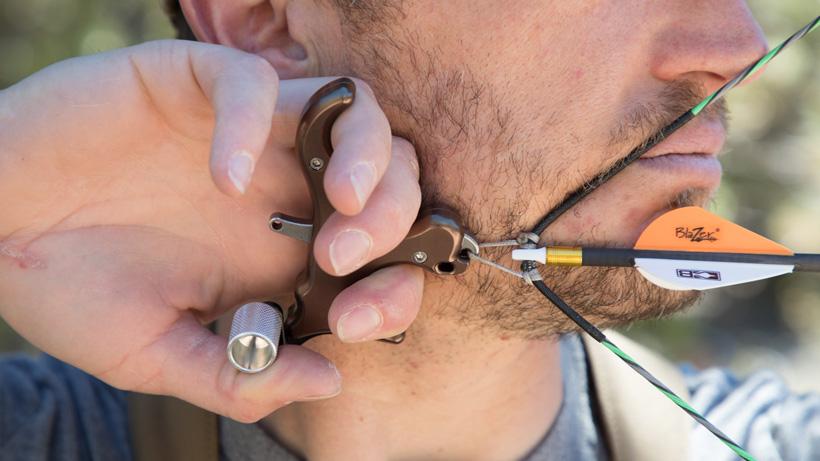
Trail Kreitzer at full draw using a Carter Chocolate Addiction thumb style archery release.
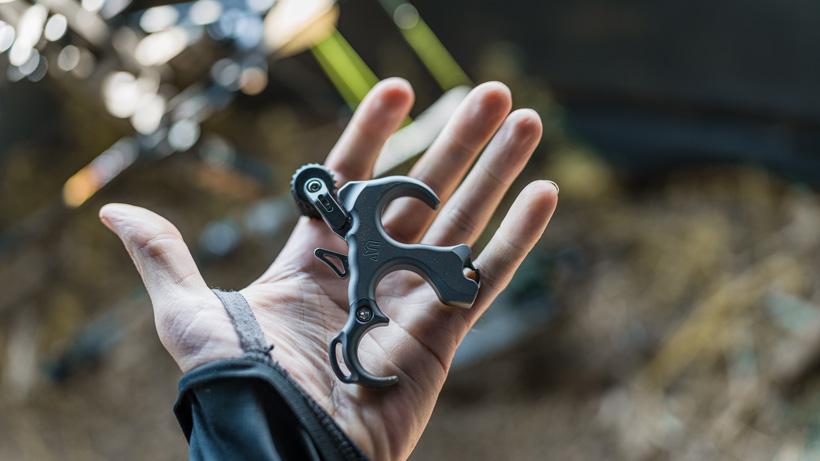
Ultraview Archery UV button release on an antelope hunt.

Close-up photo of the Carter Chocolate Addiction thumb style archery release.
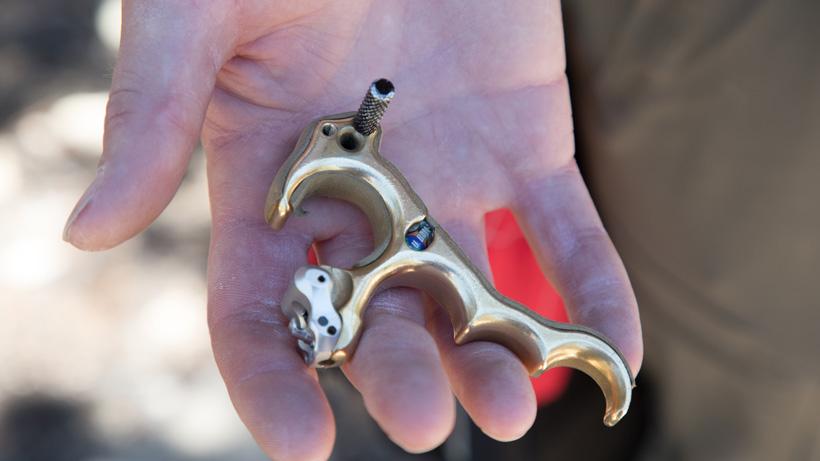
Close-up photo of a hinge style archery release for hunting.
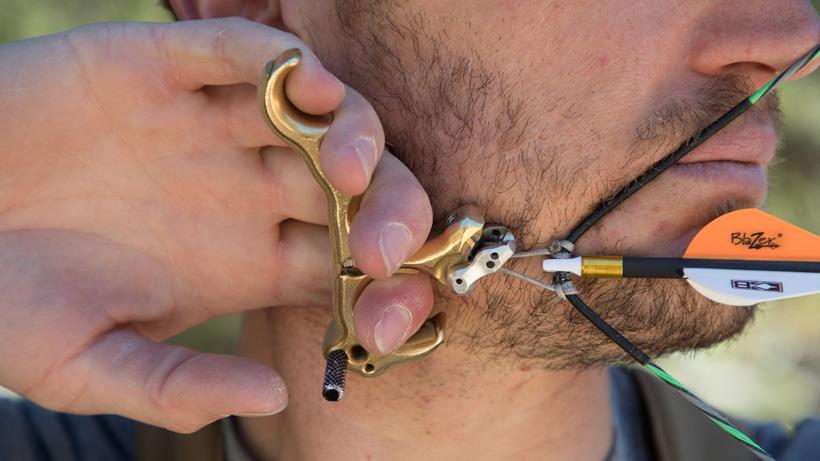


Full draw with the Carter Evolution Plus resistance style archery release. Note the thumb is off the safety mechanism in order to pull through to fire the shot.

Carter Evolution Plus resistance style archery release.
There are many different versions of archery release aids, but the four most common types are:
The features and best use of each archery release vary, and there is a ton to consider when choosing an archery release aid. In this article, we will spend some time talking about the pros, cons, and scenarios for when you might use one over another, especially when it comes to bowhunting.
The most popular release aid among bowhunters is the wrist strap index finger style. A major advantage of this type of release is that it’s familiar to most hunters. Most people begin hunting with a rifle where a trigger is pulled or squeezed to activate the shot. An index finger archery release is similar in that it has a trigger that has to be pulled to fire the arrow. It gives the archer the ability to control the shot precisely. Its commonly called “command shooting,” meaning that the archer commands the trigger, pulling it when the pin sight sits exactly on the spot where they want the arrow to hit. This can be a real advantage in a hunting situation where an animal is moving through timber and you need to pick your spot and fire an arrow at an exact moment or when a breeze is blowing and you need to execute a shot when your pin is precisely in the location you need it to be.
Another advantage of most index finger releases is that they commonly come with a wrist strap (either a buckle or velcro strap). This ensures you always have your release ready at hand when you need it. You may also find that a wrist strap helps you to pull your bow back easier than some other release options because you can utilize your wrist and muscles in your arms and back to pull.
There is a lot to like about index finger releases, but, for many of us, using an index finger release can eventually lead to “target panic.” The trigger itself isn’t the issue, but, rather, our tendencies and how we use it become the issue. Any time you have a trigger involved in activating the release you are inducing the conscious desire to fire the arrow when the pin is over the dot. Most people have a very hard time both aiming with the front half and executing a command shot with the back half. Trying to do both can lead to target panic. Target panic can be explained as the learned connection between the eye, brain and our release hand—the eye sees the pin cross the target, the brain triggers the fire reflex and the finger punches the trigger. Over time, we begin to anticipate the shot and that causes anxiety and flinching. Then, to ease the anxiety, subconsciously, we begin to aim and freeze outside of the intended target. Whatever the case the symptoms are the same: freezing off target, inconsistent shooting and flinching. If you want to continue shooting an index finger release you may need to rethink how you have it set up and how you shoot it.
Overall, index finger releases are easy to use, economical, and allow you to execute a shot quickly when you need to, but you may have to learn or relearn to shoot it a bit differently to get the most out of it.
Let’s talk about the different index finger options. We carry several models of the Carter index finger releases: Carter Quickie 1 Plus Release, and the Carter Rx1 Release. Both have hook-style heads, which are great in a hunting situation because they are simple and quiet to “hook” to your D-loop.
The Spot Hogg Wise Guy release is similar with a hook design head. Each of those offers something slightly different: trigger shape/angle, size of the head, and trigger tension adjustability.
We also carry several closed-jaw type releases. Obviously, one advantage of those is that your D-loop is enclosed, and there is no way it can come out other than opening it with the trigger. One solid option is the Spot Hogg Tuff Guy release. The Scott Archery Shark RTS and the Scott Archery Little Goose II are excellent options, both are under a $100 price point.
You will also notice that several of the index releases have nylon straps that connect the body of the release to the wrist strap itself. These nylon straps can easily be adjusted in length to find the best fit for each archer regardless of hand size. They also are flexible, allowing for some variations in anchor point and reducing torque. The downfall of these is that they can flop around a bit. We also carry some solid arm options like the Scott Archery Shark RTS, Scott Archery Little Goose II or Spot Hogg Wise Guy or Spot Hogg Tuff Guy. Those are rigid or may offer a fold-back locking option to keep them back when you don’t need them. The point of this type of release is that it won’t flop around, and you’ll easily have it in your hand when you need it. Personally, I prefer the nylon strap types because of the adjustability they provide, but it truly is a personal preference.
I’ve often heard this type of release referred to as a “thumb button.” Whether you want to call it a button or trigger, it’s the same thing. Essentially, it’s a handheld release that is activated by pulling the trigger with your thumb.
Handheld thumb trigger releases seem to be growing in popularity with hunters, perhaps bleeding over from their prominence among target archers. There are several advantages to handheld thumb releases. For one, I find that they are easier and more consistent to anchor with. The hand position utilized with a handheld release allows me to split my jaw bone between my first and second finger/knuckle. It provides an easy, comfortable, and more consistent repeatable anchor point than an index finger release. If you feel like your anchor point floats and has some inconsistencies, a handheld release can help solidify your anchor point. Most handheld releases also have closed jaw clasps that are handy when you are sitting in a tree stand or ambush hunting. Simply close the release over your D-loop, and it’s hooked up and ready to go anytime you grab it. Your draw hand is free to use an elk call or stick in your jacket pocket on a cold morning.
I often overhear other bowhunters state that they are switching to a thumb release so they can deal with their tendencies to punch the trigger on an index finger release. If you do it, switching releases can provide you the opportunity to relearn how to activate your release, but what I often see is that people pick up a handheld thumb release and start to punch the trigger on it, too. Target panic issues can continue or start just as easily with a handheld thumb trigger release as they do with an index finger release. This can be one negative of a thumb release unless you do some research and learn how to shoot a thumb release with back tension and relaxation through the hand, wrist, and draw arm. Another negative with a handheld release is that you have to keep track of it since it’s not attached to you although most do have a hole that you can attach a wrist tether to. One other potential downside is that many thumb releases have an audible click when the clasp is closed; however, the click is typically not loud enough to disturb an animal within range. One final negative is that in comparison to index finger releases, handheld thumb releases are quite expensive. A good thumb release can cost you a couple of hundred dollars.
Overall, thumb releases are great for target archery and hunting, but if you decide to try one out, I would recommend that you take the opportunity to learn to properly shoot with one so that target panic issues don’t continue or develop. One of my favorite thumb releases is the Ultraview Archery UV Button Release or the Carter Chocolate Addiction. Both releases have tons of adjustability, including trigger tension, trigger travel, and trigger location.
Another type of release is the hinge release, also known as a back tension release. It’s the type of release you may have tried to use and punched yourself in the mouth with as it went off halfway through your draw circle.
It’s intimidating to a lot of us, but in reality, it’s fairly basic and user-friendly with some tips and practice. A hinge is basically a handheld release that does not have a trigger and is only activated by the slight backward rotation of the release. When the handle rotates, it causes a searing mechanism to slip and the hook opens and the bow fires.
When you draw your bow with a hinge release, you draw with the weight on your index finger with very little tension on the rest of your fingers. You wrap your thumb around the thumb peg, utilizing the thumb peg as leverage to help you pull back. When you settle into your anchor point and begin your aiming process you will begin to pull through with your rhomboid back muscles, squeezing your draw arm shoulder blade back while relaxing your release hand, wrist and arm. As tension builds, the angle of the release changes, the sear slips, and the string fires. The major benefit of learning to shoot a hinge release is that it allows you to develop a subconscious surprise release. This might not sound like that much of a benefit, but, in essence, what you are doing is removing one variable from the equation and leaving only one thing to focus on...aiming! A hinge release can be a great tool for getting over target panic, but, once again, it will require commitment and learning to shoot one properly. Like the handheld thumb releases, a handheld hinge release also helps to establish a solid repeatable anchor point.
I personally hunt with a hinge release and have for the past 14-ish years. I had a bad case of panic, and I almost quit archery altogether. Fortunately, with the help of a friend, I learned to shoot a hinge and have rarely shot anything since. I will say that a hinge is not ideal in all hunting situations. For example, executing a very precisely timed shot is not as easy as it might be with a thumb or index finger release. Hinge releases are also handheld, which means that you have to keep track of them. It’s not as common to have a hole drilled in one to attach a wrist tether to and even on the ones that do I don’t find it comfortable to shoot with a wrist tether. So I carry it in my backpack hip pocket, and I absolutely have to keep track of it.
Most hinge releases are a hook head design, which is great for quiet and quick hook-up to a D-loop, but I also can’t hang it from a D-loop like you can with many of the handheld thumb releases.
The best answer as to why I hunt with one is because I believe it helps me execute my best shot. Here’s an example: I was already at full draw on a 330” class bull in Wyoming when I used a cow chirp to stop him. His head swiveled, staring a hole in me as I stood out in wide open space. As my pins floated around on his vitals my inner voice was screaming, “Shoot! Shoot now! He’s going to run!” But I didn’t then; my body did exactly what it had done thousands of times, tension built, the release was a surprise when it went off. I watched the arrow hit exactly where I wanted it to. I watched the bull go down within a hundred yards. I don’t know if the outcome would have been the same had I rushed the shot. Hinge releases may not be suitable for everyone, especially when hunting, but they are a valuable tool for learning a tension-activated release and as a means of managing target panic. If you learn to shoot one and become very comfortable with one, I personally feel that they are great for hunting and will help you make the best shot when it really counts.
Some great hinge releases are the Ultraview Archery The Hinge 2, Stanislawski OnneX Hinge Release and the Stanislawski Lynx Hinge Release, along with a bunch of other great options.
The last release I will touch on is a tension or resistance-activated release. It’s similar to a hinge, but has a built-in safety mechanism that allows you to draw the bow without fear of it firing. The Carter Evolution 20 Resistance Release or the Stanislawski OnneX Resistance Release is an example of this type of release. It also feels more like a traditional handheld thumb trigger release and is an awesome training tool for transitioning to a thumb release. These releases do not have a trigger, and you can’t punch it. They are fired by increasing resistance, meaning you must pull through the release for it to fire.
If you look at the Carter Evolution 20 or the Stanislawski OnneX Resistance Release, they both appear to have a trigger, but that peg where the trigger typically is on a handheld release is actually a safety that allows you to draw the bow without fear that the bow will misfire. Once you get to full draw, you find your anchor point, take your thumb off the safety, and then begin to execute your shot by pulling and building pressure on the back wall of your draw until the release fires. You can set up both releases at roughly five to seven pounds over your hold weight at full draw. This will allow you to release your thumb off the safety, and then build pressure to make the release go off.
This type of archery release aid is truly a game-changer for archers who are struggling with target panic or even archers who just want to progress and improve their shooting abilities. It can be frustrating when you initially make the switch. The most common feedback I get is that the release seems to fire sometimes, and at other times, the archer cannot get it to go off, no matter how hard they feel like they are pulling into the backwall. In those cases, the issue is not the release; rather, it is an inconsistency with the shooter.
If you commit to it, learn to shoot it, and execute the shot the same way every time, it can be a very helpful tool. In due time, it allows you to develop a subconscious, smooth, surprise release, which, in turn, grants you the opportunity to focus only on aiming. There are not many who use a tension syle archery release for hunting, but I do know a few who have gotten proficient enough that they feel comfortable to hunt with it. Most hunters are using the Carter Evolution 20 Resistance Release or the Stanislawski OnneX Resistance Release to learn to shoot with back tension and then switching to a thumb trigger release to hunt. A handheld thumb release like the Carter Chocolate Addiction or the Ultraview Archery UV Button Release can be used in the same manner as the Evolution 20 by seating the barrel of the thumb trigger on your thumb and then utilizing a relaxed hand, forearm, bicep and back tension to pull through the release to activate it. A Carter Evolution 20 resistance release is a great tool for any bowhunter.
Every archer is on a different spectrum when it comes to their experience and goals. Hopefully, everyone that reads this will find some value and direction that will help them take the next step in their progression and find a release that will help get them there.
This article was originally published on June 27, 2018, and has been updated with new release options.
Wrist strap index finger release
Handheld thumb trigger release
Handheld hinge release
Handheld resistance/tension type release